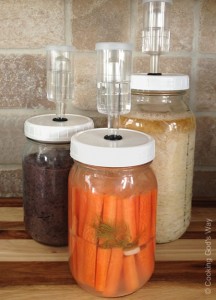 I wanted to steal the article from Jeff this week and share how I get my ferments to come out perfect every time!
I wanted to steal the article from Jeff this week and share how I get my ferments to come out perfect every time!
After seeing all the articles on the web I began to wonder why so many others were having issues. See, from my side of the fence the grass is green and life is good, and not just for me but also for the thousands of people that have taken our Lacto-fermenting Classes. Honestly, we get very few reports of problems and I have figured out why!
We know the secrets of good lacto-fermenting… and now you will too!
Secret #1 – Organic Vegetables, “Who needs ’em?!”
Fermenting blog after fermenting blog says you have to use organic vegetables. The reasoning behind this is that only organic vegetables will have the lacto-bacilli still intact for the fermenting. Here is my secret. I use some non-organic vegetables to ferment and get better results than using organic. Give me a chance to explain. I have done the research and found that many vegetables that are not organic are not sprayed or very lightly sprayed with pesticides and if I take out the ones that are known GMO’s, then I find there are still many good vegetables that are non-organic.
I know you are asking “Which vegetables are okay in a non-organic form?” If you take a look at the EWG list of pesticide sprayed vegetables you find many that are very lightly sprayed, if even sprayed at all. Cabbage barely makes the list! It is sprayed so little! I actually find that my sauerkraut comes out great time after time using regular, non-organic cabbage. Some other non-organic vegetables that have worked great for me are asparagus, onions, cauliflower, and green beans (turns out these vegetables are rarely sprayed as well). This allows me to save the money for the heavily sprayed vegetables like peppers, and cucumbers for pickles.
Secret #2 – Water Can Hinder Your Results.
Water is often expected to be all the same, but when it comes to lacto-fermenting it is not. The most important thing about the water used in lacto-fermenting is that it should be chlorine-free. Since you are trying to grow, or culture, the lacto-bacilli that is on the vegetables it would be good not to kill it before you begin! Chlorine in tap water will kill or hinder the lacto-bacilli on the vegetables. It is not hard to get chlorine free water. Just look to your refrigerator. Most refrigerators made in the last 10 years have filters for the water system and these at their lowest level remove chlorine. If you don’t have this option for chlorine free water then look to a water filter pitcher that removes chlorine that you can find at many discount stores. And if you have one, or have the means to get one, a Berkey Water Filter System is great to have in the home! I can’t stress how important the quality of your water is to your ferment.
Secret #3 – Drown it to Make it Come Alive!
Lacto-fermenting is an anaerobic process, (which means without air). Drowning your vegetables is secret #3. In other words, keep your vegetables below the surface of the liquid at all times. The problem is vegetables want to float and the brine solutions used in salt ferments make them even more buoyant. Keeping them under the brine (liquid) will virtually eliminate issues of mold or other contamination in your ferment.
There are a number of ways to keep them under the surface, and most involve some sort of weight. In the past people used river rocks they had boiled; others have tried baggies filled with liquid. Today we find weights made out of glass or porcelain, either will do the job. The weight should be, of course, non-toxic and food-safe… we don’t want chemicals leaching into our foods!
Here is our take on lacto-fermentation weights.
Why have a plain boring weight when you can have a decorative piece that looks good even when you are not using them?!
Secret #4 – Salt is More Than a Rock.
All salt is not created equal. I have found that a good quality natural salt that is unrefined works best overall. Personally, my secret salt is Himalayan Salt. Am I saying this is the only salt that will work? NO!!! Himalayan Salt has been my “go to” salt for years and I find that I get consistent results when using it in my lacto-fermentation. We also recommend this type of salt to our students and find they also have a great level of success. The only salt I will say not to use is white standard table salt, and here is why. If you are trying to make a good healthy food, why put a salt in it that is loaded with chemicals and out of balance???
Secret #5 – DIY Can Cost You.
Lacto-fermenting Kits are an important part of fermenting, allowing the necessary anaerobic environment. They not overly complicated, and there are even articles on how to “make your own”. A word of caution though… I have seen articles showing how to make your own fermenting kit using parts from the local hardware store. Yikes! These parts are not food safe and are often heavily toxic. We have received calls from people asking why their ferments tasted foul or had a chemical-y taste. More often than not, we find they made their own lacto-fermentation kits. One caller was upset because their Son had made their kits to save money and they now could not even begin to eat the foods produced because of the chemical foul taste. After throwing away many jars of food and understanding it was the parts they were using, not the process that was the problem, they realized any savings were in the garbage. We did get a follow up, and they report after using a kit “made for fermenting” (which contained natural food safe rubber parts) the taste problems completely vanished. We explained that this is why we use natural rubber parts and not industrial or silicon parts.
Also, be cautious when going to the wine shop for fermenting parts. Some of these parts are not intended to come into contact with foods in the way that they can during the lacto-fermenting process. Natural is always better.
Secret #6 – Perfection is Unreal.
Did you know that people today seem to be really hung up on perfection? Yep, and it goes beyond the Hollywood Star. Normal people expect perfection in everything they do and that includes their lacto-fermenting. They expect it to turn out perfect the first, second, and hundredth time — with no mistakes! Let me break some news to you, learning anything new has a time of mistakes. A mistake is only a mistake if you don’t learn from it. Remember the first time you tried to walk? Well you might not, but I bet your parents do, and I can guess you probably went boom! But I think by now you have walking down.
The more you lacto-ferment you will learn how the foods react to changes of the season, temperature, and quality of the vegetables themselves. The more you ferment, the better you will become at it. Learn from my secrets and keep at it! Soon you will see your refrigerator filled with great tasting and healthy lacto-fermented foods.
 Email To A Friend
Email To A Friend Print This Page
Print This Page


Do you leave the air locks on after the fermenting process is complete?
No. The air-locks are removed and replaced with the solid storage lid.
Do I need an air lock system AND a weight? Or can i skip the weight if I have an air lock system? Also, I’ve heard varying advice about fermentation time. One article said that if you ferment for less than 30 days there really isn’t much bacteria in there. But when I left my for 30 days, it was full of mold (using the air lock system). YUCK!
Dede, yes using an air-lock type system and weight together are ideal. To avoid issues with mold it is important to keep the vegetables submerged the whole time during fermenting. So that is the purpose of the weight.
I’ve seen some of the articles you are speaking about the length of fermenting. Most of them are not done by people who do not have a complete comprehension of what fermenting is. And since they do not understand it completely they just jump on the band-wagon that more bacteria must be better. But what about the other things that are happening during the fermenting process??? The boosting of the nutrition… the pre-digestion of the food… and the enhanced/increased enzymes. In fact there are quite a few vegetables that could not last a 30 day fermenting time. Take cucumbers (pickles) for instance, if you fermented them for 30 days they would be total mush…. YUCK! The softer vegetables just cannot be fermented for really long periods of time. Jeff wrote an article that you may want to take a look at to clear the whole issue about fermenting time, If You’re Eating Fermented Foods For Only This Reason, Stop!
In “Secret #3″….did you mean to say anaerobic instead of aerobic? (Actually not much difference in the spelling)
Margaret, thanks for catching that. Yes it is supposed to say “anaerobic”. Must’ve been the automatic spell-check. I’ve corrected the article now. Thanks again!